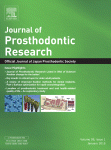Special Edition
Volume 59, Issue 1
Journal of Prosthodontic Research
Displaying 1-10 of 10 articles from this issue
- |<
- <
- 1
- >
- >|
Editorial
-
2015Volume 59Issue 1 Pages 1-2
Published: 2015
Released on J-STAGE: January 30, 2015
Download PDF (355K)
Reviews
-
2015Volume 59Issue 1 Pages 3-5
Published: 2015
Released on J-STAGE: January 30, 2015
Download PDF (506K) -
2015Volume 59Issue 1 Pages 6-19
Published: 2015
Released on J-STAGE: January 30, 2015
Download PDF (1193K)
Original Articles
-
2015Volume 59Issue 1 Pages 20-33
Published: 2015
Released on J-STAGE: January 30, 2015
Download PDF (2424K) -
2015Volume 59Issue 1 Pages 34-41
Published: 2015
Released on J-STAGE: January 30, 2015
Download PDF (665K) -
2015Volume 59Issue 1 Pages 42-48
Published: 2015
Released on J-STAGE: January 30, 2015
Download PDF (647K) -
2015Volume 59Issue 1 Pages 49-54
Published: 2015
Released on J-STAGE: January 30, 2015
Download PDF (565K) -
2015Volume 59Issue 1 Pages 55-61
Published: 2015
Released on J-STAGE: January 30, 2015
Download PDF (1230K) -
2015Volume 59Issue 1 Pages 62-70
Published: 2015
Released on J-STAGE: January 30, 2015
Download PDF (1663K) -
2015Volume 59Issue 1 Pages 71-78
Published: 2015
Released on J-STAGE: January 30, 2015
Download PDF (1489K)
- |<
- <
- 1
- >
- >|
